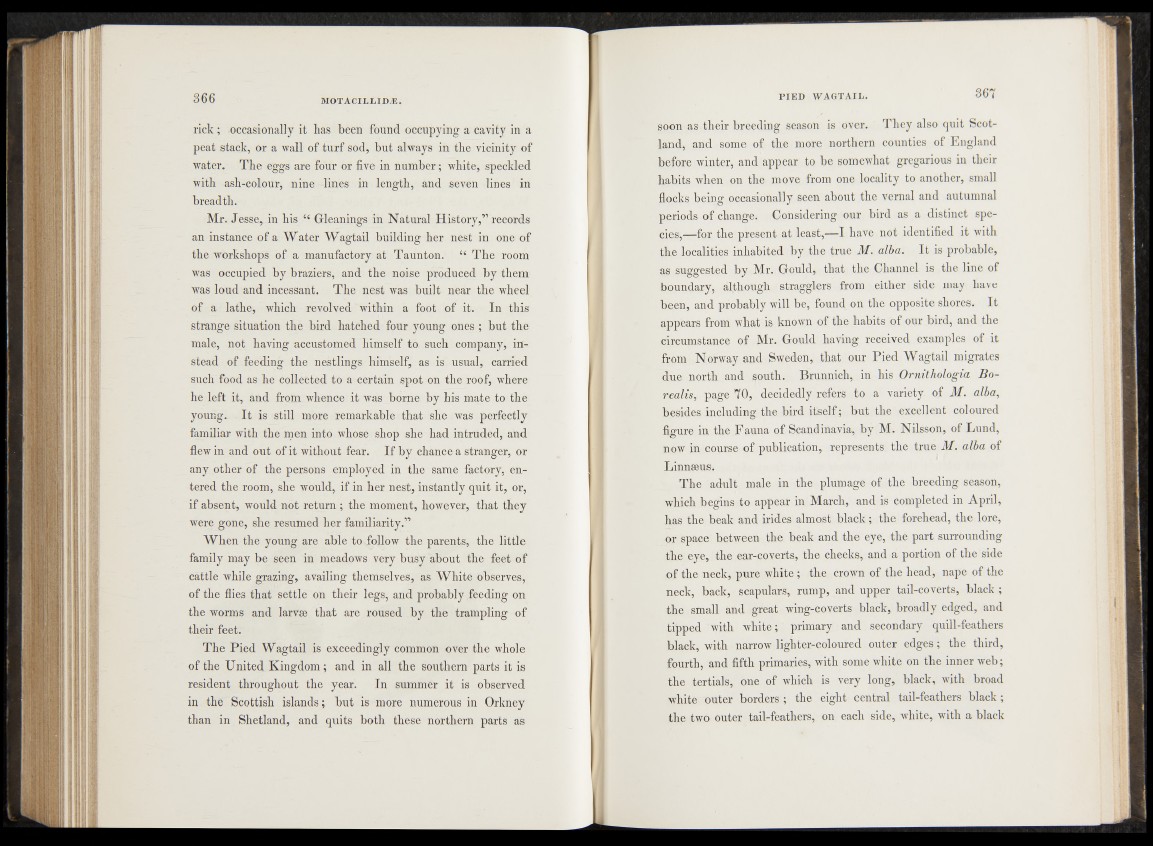
rick ; occasionally it has been found occupying a cavity in a
peat stack, or a wall of turf sod, but always in the vicinity of
water. The eggs are four or five in number; white, speckled
with ash-colour, nine lines in length, and seven lines in
breadth.
Mr. Jesse, in his (< Gleanings in Natural History,” records
an instance of a Water Wagtail building her nest in one of
the workshops of a manufactory at Taunton. “ The room
was occupied by braziers, and the noise produced by them
was loud and incessant. The nest was built near the wheel
of a lathe, which revolved within a foot of it. In this
strange situation the bird hatched four young ones ; but the
male, not having accustomed himself to such company, instead
of feeding the nestlings himself, as is usual, carried
such food as he collected to a certain spot on the roof, where
he left it, and from whence it was borne by his mate to the
young. I t is still more remarkable that she was perfectly
familiar with the men into whose shop she had intruded, and
flew in and out of it without fear. If by chance a stranger, or
any other of the persons employed in the same factory, entered
the room, she would, if in her nest, instantly quit it, or,
if absent, would not return; the moment, however, that they
were gone, she resumed her familiarity.”
When the young are able to follow the parents, the little
family may be seen in meadows very busy about the feet of
cattle while grazing, availing themselves, as White observes,
of the flies that settle on their legs, and probably feeding on
the worms and larvae that are roused by the trampling of
their feet.
The Pied Wagtail is exceedingly common over the whole
of the United Kingdom; and in all the southern parts it is
resident throughout the year. In summer it is observed
in the Scottish islands; but is more numerous in Orkney
than in Shetland, and quits both these northern parts as
soon as their breeding season is over. They also quit Scotland,
and some of the more northern counties of England
before winter, and appear to be somewhat gregarious in their
habits when on the move from one locality to another, small
flocks being occasionally seen about the vernal and autumnal
periods of change. Considering our bird as a distinct species,—
for the present at least,—I have not identified it with
the localities inhabited by the true M. alba. It is probable,
as suggested by Mr. Gould, that the Channel is the line of
boundary, although stragglers from either side may have
been, and probably will be, found on the opposite shores. It
appears from what is known of the habits of our bird, and the
circumstance of Mr. Gould having received examples of it
from Norway and Sweden, that our Pied Wagtail migrates
due north and south. Brunnich, in his Ornithologia Borealis,
page 70, decidedly refers to a variety of M. alba,
besides including the bird itself; but the excellent coloured
figure in the Fauna of Scandinavia, by M. Nilsson, of Lund,
now in course of publication, represents the true M. alba of
Linnseus.
The adult male in the plumage of the breeding season,
which begins to appear in March, and is completed in April,
has the beak and irides almost black; the forehead, the lore,
or space between the beak and the eye, the part surrounding
the eye, the ear-coverts, the cheeks, and a portion of the side
of the neck, pure white ; the crown of the head, nape of the
neck, back, scapulars, rump, and upper tail-coverts, black ;
the small and great wing-coverts black, broadly edged, and
tipped with white; primary and secondary quill-feathers
black, with narrow lighter-coloured outer edges; the third,
fourth, and fifth primaries, with some white on the inner web;
the tertials, one of which is very long, black, with broad
white outer borders ; the eight central tail-feathers black;
the two outer tail-feathers, on each side, white, with a black